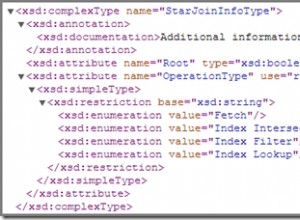निम्न क्वेरी आपको SQL के होने वाले खंड और MySQL के group_concat समारोह।
मेरे द्वारा उपयोग की गई तालिका परिभाषा और नमूना डेटा निम्नलिखित है:
drop table nested_set;
CREATE TABLE nested_set (
id INT,
name VARCHAR(20) NOT NULL,
lft INT NOT NULL,
rgt INT NOT NULL
);
INSERT INTO nested_set (id, name, lft, rgt) VALUES (1,'HEAD',1,28);
INSERT INTO nested_set (id, name, lft, rgt) VALUES (2,'A',2,3);
INSERT INTO nested_set (id, name, lft, rgt) VALUES (3,'B',4,17);
INSERT INTO nested_set (id, name, lft, rgt) VALUES (4,'B1',5,10);
INSERT INTO nested_set (id, name, lft, rgt) VALUES (5,'B1.1',6,7);
INSERT INTO nested_set (id, name, lft, rgt) VALUES (6,'B1.2',8,9);
INSERT INTO nested_set (id, name, lft, rgt) VALUES (7,'B2',11,16);
INSERT INTO nested_set (id, name, lft, rgt) VALUES (8,'B2.1',12,13);
INSERT INTO nested_set (id, name, lft, rgt) VALUES (9,'B2.2',14,15);
INSERT INTO nested_set (id, name, lft, rgt) VALUES (10,'C',18,25);
INSERT INTO nested_set (id, name, lft, rgt) VALUES (11,'C1',19,20);
INSERT INTO nested_set (id, name, lft, rgt) VALUES (12,'C2',21,22);
INSERT INTO nested_set (id, name, lft, rgt) VALUES (13,'C3',23,24);
INSERT INTO nested_set (id, name, lft, rgt) VALUES (14,'D',26,27);
निम्नलिखित प्रश्न आपको पूरा पेड़ देता है (सिर को छोड़कर):
SELECT
node.id
, node.lft
, node.rgt
, node.name
, GROUP_CONCAT(parent.name ORDER BY parent.lft SEPARATOR "/" ) AS path
, (COUNT(parent.lft) - 1) AS depth
FROM nested_set AS node
inner join nested_set AS parent
on node.lft BETWEEN parent.lft AND parent.rgt
where parent.lft > 1
GROUP BY node.id
नमूना डेटा के विरुद्ध चलाने पर निम्न के आउटपुट के साथ:
+------+-----+-----+------+-----------+-------+
| id | lft | rgt | name | path | depth |
+------+-----+-----+------+-----------+-------+
| 2 | 2 | 3 | A | A | 0 |
| 3 | 4 | 17 | B | B | 0 |
| 4 | 5 | 10 | B1 | B/B1 | 1 |
| 5 | 6 | 7 | B1.1 | B/B1/B1.1 | 2 |
| 6 | 8 | 9 | B1.2 | B/B1/B1.2 | 2 |
| 7 | 11 | 16 | B2 | B/B2 | 1 |
| 8 | 12 | 13 | B2.1 | B/B2/B2.1 | 2 |
| 9 | 14 | 15 | B2.2 | B/B2/B2.2 | 2 |
| 10 | 18 | 25 | C | C | 0 |
| 11 | 19 | 20 | C1 | C/C1 | 1 |
| 12 | 21 | 22 | C2 | C/C2 | 1 |
| 13 | 23 | 24 | C3 | C/C3 | 1 |
| 14 | 26 | 27 | D | D | 0 |
+------+-----+-----+------+-----------+-------+
उपरोक्त क्वेरी में निम्नलिखित जोड़ आपको विभिन्न अनुभागों को खोलने के लिए आवश्यक नियंत्रण प्रदान करेंगे:
having
depth = 0
or ('<PATH_TO_OPEN>' = left(path, length('<PATH_TO_OPEN>'))
and depth = length('<PATH_TO_OPEN>') - length(replace('<PATH_TO_OPEN>', '/', '')) + 1)
होने वाला खंड क्वेरी द्वारा समूह के परिणामों पर फ़िल्टर लागू करता है। "गहराई =0" भाग यह सुनिश्चित करने के लिए है कि हमारे पास हमेशा आधार मेनू नोड्स (ए, बी, सी, और डी) हों। अगला भाग वह भाग है जो नियंत्रित करता है कि कौन से नोड खुले हैं। यह एक सेट पथ के साथ नोड्स के पथ की तुलना करता है जिसे आप खोलना चाहते हैं ('') यह देखने के लिए कि क्या यह मेल खाता है और यह भी सुनिश्चित करता है कि यह केवल पथ में स्तर खोलता है। पूरे या खंड को '' तर्क के साथ दोहराया जा सकता है और आवश्यकतानुसार कई पथ खोलने के लिए आवश्यकतानुसार जोड़ा जा सकता है। सुनिश्चित करें कि '' एक अनुगामी स्लैश (/) में समाप्त नहीं होता है।
आपको यह दिखाने के लिए कुछ आउटपुट उदाहरण निम्नलिखित हैं कि आप अपने इच्छित आउटपुट प्राप्त करने के लिए क्वेरी कैसे बनाएंगे:
=========Open B==========
SELECT
node.id
, node.lft
, node.rgt
, node.name
, GROUP_CONCAT(parent.name ORDER BY parent.lft SEPARATOR "/" ) AS path
, (COUNT(parent.lft) - 1) AS depth
FROM nested_set AS node
inner join nested_set AS parent
on node.lft BETWEEN parent.lft AND parent.rgt
where parent.lft > 1
GROUP BY node.id
having
depth = 0
or ('B' = left(path, length('B'))
and depth = length('B') - length(replace('B', '/', '')) + 1)
+------+-----+-----+------+------+-------+
| id | lft | rgt | name | path | depth |
+------+-----+-----+------+------+-------+
| 2 | 2 | 3 | A | A | 0 |
| 3 | 4 | 17 | B | B | 0 |
| 4 | 5 | 10 | B1 | B/B1 | 1 |
| 7 | 11 | 16 | B2 | B/B2 | 1 |
| 10 | 18 | 25 | C | C | 0 |
| 14 | 26 | 27 | D | D | 0 |
+------+-----+-----+------+------+-------+
=========Open B and B/B1==========
SELECT
node.id
, node.lft
, node.rgt
, node.name
, GROUP_CONCAT(parent.name ORDER BY parent.lft SEPARATOR "/" ) AS path
, (COUNT(parent.lft) - 1) AS depth
FROM nested_set AS node
inner join nested_set AS parent
on node.lft BETWEEN parent.lft AND parent.rgt
where parent.lft > 1
GROUP BY node.id
having
depth = 0
or ('B' = left(path, length('B'))
and depth = length('B') - length(replace('B', '/', '')) + 1)
or ('B/B1' = left(path, length('B/B1'))
and depth = length('B/B1') - length(replace('B/B1', '/', '')) + 1)
+------+-----+-----+------+-----------+-------+
| id | lft | rgt | name | path | depth |
+------+-----+-----+------+-----------+-------+
| 2 | 2 | 3 | A | A | 0 |
| 3 | 4 | 17 | B | B | 0 |
| 4 | 5 | 10 | B1 | B/B1 | 1 |
| 5 | 6 | 7 | B1.1 | B/B1/B1.1 | 2 |
| 6 | 8 | 9 | B1.2 | B/B1/B1.2 | 2 |
| 7 | 11 | 16 | B2 | B/B2 | 1 |
| 10 | 18 | 25 | C | C | 0 |
| 14 | 26 | 27 | D | D | 0 |
+------+-----+-----+------+-----------+-------+
=========Open B and B/B1 and C==========
SELECT
node.id
, node.lft
, node.rgt
, node.name
, GROUP_CONCAT(parent.name ORDER BY parent.lft SEPARATOR "/" ) AS path
, (COUNT(parent.lft) - 1) AS depth
FROM nested_set AS node
inner join nested_set AS parent
on node.lft BETWEEN parent.lft AND parent.rgt
where parent.lft > 1
GROUP BY node.id
having
depth = 0
or ('B' = left(path, length('B'))
and depth = length('B') - length(replace('B', '/', '')) + 1)
or ('B/B1' = left(path, length('B/B1'))
and depth = length('B/B1') - length(replace('B/B1', '/', '')) + 1)
or ('C' = left(path, length('C'))
and depth = length('C') - length(replace('C', '/', '')) + 1)
+------+-----+-----+------+-----------+-------+
| id | lft | rgt | name | path | depth |
+------+-----+-----+------+-----------+-------+
| 2 | 2 | 3 | A | A | 0 |
| 3 | 4 | 17 | B | B | 0 |
| 4 | 5 | 10 | B1 | B/B1 | 1 |
| 5 | 6 | 7 | B1.1 | B/B1/B1.1 | 2 |
| 6 | 8 | 9 | B1.2 | B/B1/B1.2 | 2 |
| 7 | 11 | 16 | B2 | B/B2 | 1 |
| 10 | 18 | 25 | C | C | 0 |
| 11 | 19 | 20 | C1 | C/C1 | 1 |
| 12 | 21 | 22 | C2 | C/C2 | 1 |
| 13 | 23 | 24 | C3 | C/C3 | 1 |
| 14 | 26 | 27 | D | D | 0 |
+------+-----+-----+------+-----------+-------+
यह इसके बारे में। आप बस उस प्रत्येक पथ या अनुभाग की नकल करते रहें जिसे आपको खोलने की आवश्यकता है।
देखें http://mikehillyer.com/articles/managing-hierarchical-data -in-mysql/ यदि आपको MySQL में नेस्टेड सेट के साथ काम करने के बारे में सामान्य जानकारी चाहिए।
अगर आपके कोई प्रश्न हैं तो मुझे बताएं।
एचटीएच,
-डिपिन




